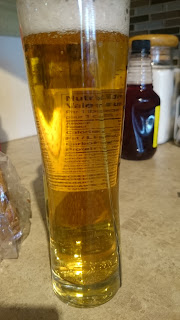I know that most people will tell you that you don't start brewing beer to save money because with all the equipment and ingredients and such you won't end up saving much, but it doesn't hurt to try. Especially with Canadian beer prices, and especially when you're the typical broke-ass university student, every little bit helps. I try to buy all my hops and grain in bulk, and with my lab equipment I can keep culturing yeasts as long as possible - these things help to save $10 here and there. In buying base grain, To have to buy Marris Otter or other darker base malts, Pilsner malt for especially light malt, and 2-row for neutral american bases gives me 300% the spending that I would have if I were to just buy one type of base malt at a time.
So the question remains: Is it completely necessary to buy Pilsner malt to make a Pilsner?
I tried my best to do what I could with the 2-row I have. For this recipe it is 100% 2-row base malt, and Hallertauer hops. I really love Saaz hops, but I'm working at a prion research lab for the summer and both my PI's are German, so I figured I would go for it to try for a German Pilsner rather than a Czech Pils. I have a full pound of Saaz so I will definitely be trying to burn through that - Pilsners on the constant rotation!

I've been told that Pilsner malt is essential for a Pilsner, but I didn't want to go out and buy more malt for one recipe. Pilsner malt - I've been told - has a doughy and light grainy flavour from its lighter kilning which makes it more flavourful than simple 2-row base malt. I definitely noticed such a flavor with my last Czech Pilsner, but it could have been confirmation bias.
To try to up the game of maltiness with the 2-row I did a single decoction mash, but the decoction was especially long. I removed about 2 litres of grain from the mash and brought it to a boil on the stove while the rest of the beer mashed. I allowed it to decoct for about the full hour long mash while stirring constantly which was a pain in the butt. I usually toss a bit of Munich malt in my Pilsner as well to get some melanoidins in there, but I didn't even have that, so I guess this could be called a SMaSH pilsner- single malt and single hops.
For the water in my Czech Pils I start with distilled and add very little mineral additions to give it a soft profile. German Pilsners typically have a harder water profile with more minerals, so I just used my straight Calgary tap water, which is fairly high in minerals and carbonate.
I brewed this beer quite a while ago, but have been quite busy with my research job and some spring courses so I've been putting off posting. The brewday was typical, Mash, sparge, boil, chill, pitch a ton of lager yeast, and ferment cold, and diacetyl rest. I used Brulosopher's fast lager method, which has always worked out well for me! The beer turned out quite well, and the German bosses have said it was their favorite of the ones I gave him, and called it "exceptional" which puts a smile on my face.

This is warm, so this picture is a lie.
Tasting notes:
Appearance: The pictured glass is cellar temperature, and I snapped some pictures before dinner. After refrigeration this beer generally has a light chill haze, so I apologize for the misleading clarity. The head is pure white, and sticks to the glass to make a nice lacing.
Aroma: Light floral hops, a bit of a peppery hoppy smell. A bit of grainy aroma, no sulfur, no diacetyl.
Flavor: Light hoppiness follows the aroma, same lightly spicy and floral typical of noble hops. There's a grainy finish, but also a tiny bit of a sort of sulfur? flavor that I always taste in Pilsners. It's medium-dry, and quite crisp. The bitterness is pretty firm.
Mouthfeel: Moderate-low carbonation. Moderate body. I goofed on this bottling, and must not have stirred the priming solution well enough so I've had a few glasses undercarbonated and a few that foamed to high heaven while I was camping.
Overall: I like it, and there's a grainy dough flavor that reminds me of the last Czech pils I brewed, but I'll be honest: it does seem to be missing that je-ne-sais-quoi. I'm tickled and proud that some straight-up Bavarians really liked my beer and requested more of it, and complimented me on it, but this isn't quite perfect to my tastes. I prefer it more hoppy, more Saaz, and some more doughyness that may have been helped by my usual dose of Munich malt. This isn't a good experiment, and there's no side-by-side, but that's just my opinion, man.
The beer is good, and there's nothing inherently wrong with it, but there's a difference that may just be in my head. I don't have much in terms of income, so I'll probably stick with the 2-row. For Marris Otter beers, I'll still probably supplement with a portion of amber malt for toastiness. One day I'll have more base-malts, but today is not that day!
Recipe:
10# 2-row (Canada Malting)
2 oz Hallertauer - 60 mins
1.5 oz Hallertauer - Whirlpool.
Mashed at 150*F, 2 litre decoction for 1 hour.
Fermented as per Brulosopher's Fast Lager method.

No comments:
Post a Comment